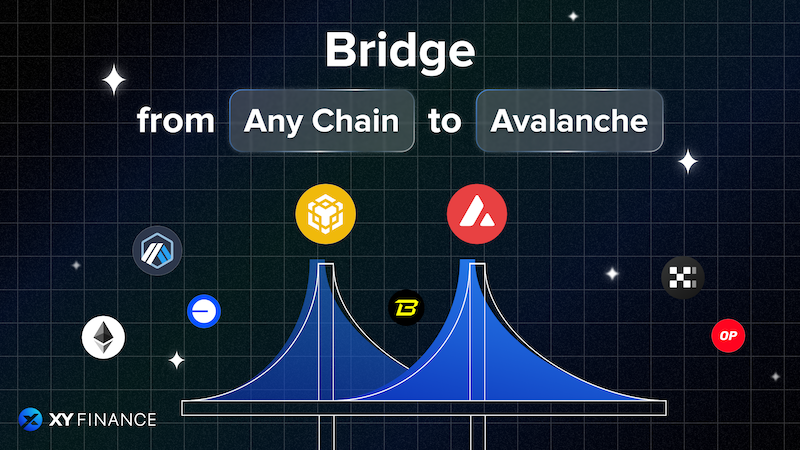
Thinking of bridge your assets to Avalanche? Read on for a comprehensive guide to its pros, cons, and a handy guide on how to do it!
Why Bridge to Avalanche? Understanding the Benefits
Avalanche (AVAX) is a blockchain platform launched in 2020 aiming to be fast, secure, and scalable, addressing the “blockchain trilemma” of balancing these three crucial aspects.
It utilizes a novel Proof-of-Stake (PoS) consensus mechanism designed for high throughput. When a user initiates a transaction, a validator node receives it and samples a small set of other validators to verify agreement. This process repeats as validators “communicate with each other” to reach consensus.
Imagine this process like a snowball rolling downhill. As each validator confirms the transaction with more validators, it becomes increasingly unlikely to be reversed, similar to how a snowball grows larger and more difficult to stop. This rapid consensus mechanism is what gives Avalanche its name.
In addition to its consensus mechanism, there are some unique advantages that you should connect to Avalanche:
- High Transaction Speed and Scalability: Avalanche boasts impressive transaction speeds, capable of processing thousands of transactions per second (TPS) with low latency, significantly outperforming Ethereum.
- Low Transaction Fees: Avalanche’s transaction fees are significantly lower compared to Ethereum, making it a more cost-effective platform for users to move and utilize their assets.
- Thriving DeFi Ecosystem: Avalanche hosts a rapidly growing DeFi ecosystem, offering a diverse range of DApps for lending, borrowing, yield farming, and other financial services.
- Enhanced Security: Avalanche consensus is designed to resist various attacks, including sybil attacks, distributed denial-of-service (DDoS) attacks, and collusion attacks.
- Developer-Friendly Environment: Avalanche provides a developer-friendly environment with comprehensive documentation, tools, and resources, enabling developers to build and deploy DApps on the platform with ease.
Now that you know what sets Avalanche apart, let’s explore how you can transfer your crypto assets to Avalanche!
How to Bridge to Avalanche? Why is Avalanche Official Bridge Not the Best Choice?
As the name suggests, one might assume that the Avalanche Official Bridge is the simplest or easiest way to transfer assets to and from Avalanche. However, it does have a few drawbacks:
- The official Avalanche bridge facilitates asset transfers exclusively among Ethereum, Bitcoin, and Avalanche, without connectivity to other Layer 1 or Layer 2 networks.
- It only supports 24 mainstream tokens, requiring users to convert unsupported tokens into compatible ones for bridging purposes.
Given the above limitations of the official bridge, you may wonder about the potential of using third-party cross-chain bridges to facilitate your asset transfers to Avalanche. Why not do it with XY Finance? It’s an efficient and user-friendly way to move your assets to and from 20+ different chains!
Bridge Crypto to Avalanche Step-by-Step Guide from BNB, Optimism, Arbitrum, and other L2s
XY Finance is a cross-chain bridge aggregator that operates on 20 EVM chains, including BNB, Optimism, Arbutrum, and more. XY Finance boasts a user-focused approach that makes transferring tokens between different chains a lot easier and much more efficient. This provides users with the best options at the most affordable prices too.
Read on below for a step-by-step guide to discover just how easy it is to execute a cross-chain swap at the most competitive prices on XY Finance!
⓵ Visit Swap page and Click “Connect wallet”
Start your cross-chain journey
⓶ Connect Your Web3 Wallet
Up to 10 of the most common wallets available!
⓷ Select the Tokens & Chains Accordingly
Cross-chain or single-chain swap are both available.
⓸ Check the Details
Choose the route and click “Review Route”.
⓹Approve & Confirm to Swap
Click “Transfer” and confirm the message from your wallet.
(For the first time, users need to approve the token to allow XY Finance access.)
⓺ Wait for the transaction to be completed
Transaction status can be tracked on the screen
In most cases, cross-chain transactions will be completed within minutes. To view your past transaction records, you can click the ‘Transaction’ button.
If your transaction cannot be completed, please raise a ticket in the XY Finance Discord. Our team will be happy to help you resolve the issue as soon as possible.
After Bridging to Avalanche: Exploring Promising Avalanche Ecosystem!
Now that you have the know-how on transferring your assets to Avalanche successfully, let’s get to the exciting part. You can now start exploring various protocols within the wide Avalanche ecosystem. Whether you’re interested in DeFi, NFTs, or anything in between, you’ll find something in the Avalanche ecosystem that fits your tastes.
Security in Cross-Chain Transactions
Whenever you transfer assets from one blockchain network to another, it’s your responsibility to make sure the transactions—and your assets—are secure. Keep reading below for a few pointers you can keep in mind to maintain your digital assets’ security.
- Verify the authenticity of the bridge service that you’re using
- Carefully review your transaction details before you finalize them
- Keep your private keys and wallet information in a secure location
- Stay updated about and remain vigilant against phishing sites and scams
Bridging assets to Avalanche is a great bit of knowledge for any Web3 enthusiast’s arsenal. We wrote this comprehensive guide to help add to your understanding of DeFi, as well as guide you to become a more well-rounded and knowledgeable participant in this quick-shifting, ever-changing landscape of blockchain technology. Let’s keep informed about the latest trends in DeFi together—so you can continue to broaden your horizons in this dynamic landscape!
Other Bridging Tutorials for You
Now that you know how to bridge to Avalanche, don’t stop there! You can just as easily bridge your assets to different blockchains as you wish with XY Finance. For more detailed information on how to do this, visit XY blog or check out these step-by-step guides below.